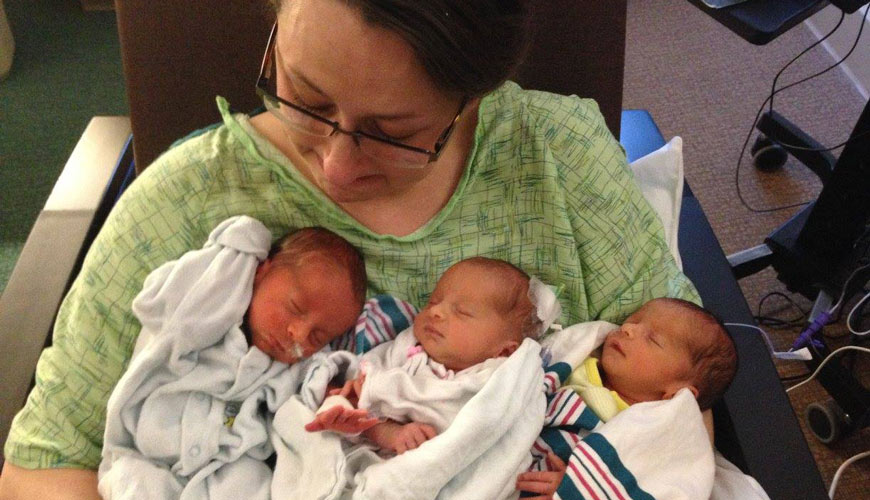
What All New Moms Need To Know About Blood Clot Risk
Dr. Pari was featured as a guest contributor in the article below, originally posted for SELF by Korin Miller.
A Kansas mother of five died from a blood clot in her lungs just a week after giving birth to triplets. And, while seemingly unrelated, doctors say Casi Rott’s recent childbirth experience was tied to her cause of death.
A few days after giving birth, Rott woke up in the middle of the night, complaining of chest pains and a fast heartbeat, her husband, Joey, wrote on Facebook. Joey drove her to the hospital, where a CT scan found a large blood clot in her lungs. “It’s very likely the clot was caused by the pregnancy and C-Section,” Joey wrote. “She should be released this weekend but will have to take it easy for a quite a while with additional tests daily to monitor everything.”
But soon after leaving the hospital, Casi’s chest pain returned. As Joey drove her to the hospital “things turned for the worst,” he told People.com. “I was driving and suddenly she just passed out.”
“She wasn’t moving the entire time. I didn’t know if she was breathing,” he says. “But it was too late. The people at the hospital did all they could do. They worked on her for over an hour.”
While uncommon, new mothers are at an increased risk for developing blood clots (known as venous thromboembolism) for up to 12 weeks after giving birth, according to a recent study from Weill Cornell Medical College researchers. The study discovered that 22 clot-related strokes, heart attacks, and clots in the legs or lungs occur within six weeks postpartum in every 100,000 deliveries, and another three clots occur in the next six weeks. After 12 weeks, the risk goes back to normal.
Lead study researcher Hooman Kamel, M.D., an assistant professor of neurology and neuroscience in Weill Cornell Medical College’s department of neurology, tells SELF that there are multiple reasons why these clots may occur, although they’re not entirely understood. “We think that normal physiology changes in many ways in order to accommodate a pregnancy, and in rare cases, some of these changes may cause the blood itself to become more likely to clot,” he says. Pregnancy can also affect the lining of the blood vessels, he adds, which may cause blood clots to form at the site of the damaged blood vessel.
Jason James, M.D., medical director at Miami’s FemCare Ob-Gyn, tells SELF that women who have twins or triplets are also at a higher risk of developing clots that those who give birth to a single baby. “One of the risk factors for developing a blood clot is something called stasis, where the blood flow is decreased, and this occurs due to compression of the veins by the uterus,” explains. “A woman with a very enlarged uterus such as would be seen in multiple gestation is likely to have more compression.” C-section births can also put a woman at a higher risk of developing a blood clot, says James, putting Casi Rott at an even greater risk than most new moms.
Postnatal blood clots most commonly develop in the legs, Kamel says, but they can travel to the mom’s lungs, heart, and brain.
Doctors will typically watch for signs and symptoms of blood clots in new moms, board-certified ob-gyn Pari Ghodsi, M.D., tells SELF, but given the potentially serious consequence of developing a blood clot, it’s a good idea to know them for yourself.
A blood clot in the legs will often cause pain or swelling in one leg, a clot in the heart or lungs will often result in chest pain or pressure, a rapid heartbeat, and difficulty breathing, and a blood clot in the brain may cause a sudden and severe headache, a sudden change in consciousness, speech, balance, or strength on one side of the body. If you’ve recently given birth and experience any of these symptoms, Ghodsi recommends calling your doctor or, if the symptoms are severe, visiting the emergency room ASAP.
Luckily, James says doctors are aware of the risk and many have implemented preventative measures to reduce the odds that this will happen. Those include encouraging women to walk soon after delivering and putting women on special compression devices for their lower extremities after a C-section until they are walking consistently. For women with other risk factors, like an inherited blood disorder, medications like blood thinners are also used. “The incidence of venous thromboembolism has declined in the last 30 years due to the implementation of measures such as these,” says James.
While postnatal blood clots are scary, Kamel points out that they’re not common and most are not fatal if caught in time. “For the vast majority of women, this is not something that will affect them,” he says.
A GoFundMe page has been set up for the Rott family, which has already raised more than $135,000.